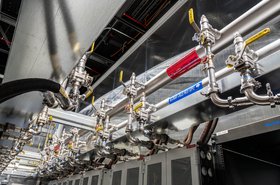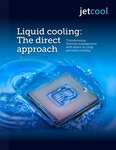As AI applications become increasingly sophisticated and pervasive across sectors including finance, healthcare, manufacturing, and more, data center providers face unique challenges in adapting their infrastructure to support these demanding workloads.
One of the primary challenges lies in efficiently managing substantial heat generated by AI operations. The increasing computational demands of AI algorithms necessitate cutting-edge thermal management to maintain system stability and efficiency.
Efficient and effective cooling solutions are paramount to ensure optimal performance, reliability, and longevity of IT systems, and data center operators are under significant pressure to innovate and integrate advanced cooling technologies capable of efficiently handling the heat generated by AI applications.
Many data center operators are turning to liquid cooling. Traditional air-cooled systems, often used in data centers, may struggle to adequately dissipate the high heat density generated by AI workloads.
Methods like immersion cooling and direct-to-chip cooling efficiently disperse heat directly from critical components, reducing the risk of performance degradation and hardware failures caused by overheating.
When it comes to liquid cooling, it’s important to note that there are multiple options available to data center providers – meaning that operators are increasingly designing facilities to accommodate multiple types of cooling technologies within the same environment.
Immersion cooling - involves submerging specially designed IT hardware, such as servers and graphics processing units (GPUs), into a dielectric fluid like mineral oil or synthetic coolant. This fluid directly absorbs heat from the components, providing efficient and direct cooling without relying on traditional air-cooled systems. This method significantly enhances energy efficiency and reduces operational costs, making it particularly suitable for AI workloads that generate substantial heat.
Direct-to-chip cooling, also known as microfluidic cooling - delivers coolant directly to the heat-generating components of servers, such as central processing units (CPUs) and GPUs. This targeted approach maximizes thermal conductivity, efficiently dissipating heat at the source and improving overall performance and reliability.
Implementing more than one method for optimal results
The versatility and flexibility of liquid cooling technologies provides data center operators with the option of adopting a mix-and-match approach tailored to specific infrastructure and AI workload requirements. This means that air cooling systems will continue to be part of the data center infrastructure for the foreseeable future, complementing liquid cooling solutions.
Integrating multiple cooling solutions enables providers to:
- Optimize Cooling Efficiency: Each cooling technology has unique strengths and limitations. Different types of liquid cooling can be deployed in the same data center, or even the same hall. By combining immersion cooling, direct-to-chip cooling and/or air cooling, providers can leverage the benefits of each method to achieve optimal cooling efficiency across different components and workload types.
- Address Varied Cooling Needs: AI workloads often consist of diverse hardware configurations with varying heat dissipation characteristics. A mix-and-match approach allows providers to customize cooling solutions based on specific workload demands, ensuring comprehensive heat management and system stability.
- Enhance Scalability and Adaptability: As AI workloads evolve and data center requirements change, a flexible cooling infrastructure that supports scalability and adaptability becomes essential. Integrating multiple cooling technologies provides scalability options and facilitates future upgrades without compromising cooling performance. For example, air cooling can support high-performance computing (HPC) and AI workloads to a degree, and most AI deployments will continue to require supplementary air-cooled systems for networking infrastructure.
All cooling types ultimately require waste heat to be removed or re-used, so the main heat rejection system (such as chillers) must be sized appropriately and enabled for heat reuse where possible.
Addressing Challenges
Liquid cooling offers a more sustainable option in comparison to other thermal management technologies. It reduces energy consumption as it takes less electricity to cool servers than air cooling systems. However, despite these benefits, there are a number of challenges to be overcome for operators interested in embracing liquid cooling innovation:
- Initial Investment: Liquid cooling systems require higher upfront costs compared to traditional air-based solutions. A careful cost-benefit analysis and long-term planning are necessary to demonstrate the return on investment (ROI) in terms of energy savings and performance improvements for AI workloads.
- Complexity of Integration: Liquid cooling solutions need specialized components and careful integration into existing infrastructure. Retrofitting older data centers can be complex and costly, whereas new data centers can be designed with these demands in mind. Investment in skilled personnel and training is crucial for effectively deploying and maintaining these systems.
- Scalability: As AI workloads grow, data center infrastructure must scale efficiently to accommodate increasing computational demands while maintaining effective heat dissipation. Cooling systems must adapt to changing requirements without compromising performance or reliability.
Cool and sustainable
Effective cooling solutions are paramount if data centers are to meet the ever-growing demands of AI workloads – and liquid cooling technologies play a pivotal role in enhancing performance, increasing energy efficiency, and improving the reliability of AI-centric operations.
The adoption of advanced liquid cooling technologies not only optimizes heat management and reuse but also contributes to reducing environmental impact by enhancing energy efficiency and enabling the integration of renewable energy sources into data center operations.





